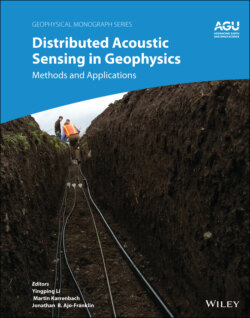Читать книгу Distributed Acoustic Sensing in Geophysics - Группа авторов - Страница 49
2.6. PROCESSING ISSUES 2.6.1. Angle of Incidence
ОглавлениеThe fiber’s response to P‐waves is somewhat similar to a single‐component geophone. Bakku (2015) compared the far‐field P‐wave response for geophones (cosΘ) to optical fiber (cos2Θ), where Θ is the angle of incidence of the wave hitting the fiber; 90° indicates normal to the fiber, and 0° is along the axial direction of the fiber. The solid line in Figure 2.9 (left) shows the response for a geophone oriented in the axial direction of the fiber, and the dashed line shows the fiber response for P‐waves. They are identical for normal and perpendicular angles but differ at intermediate angles, with the largest difference at 45°. Figure 2.9 (right) shows the far‐field S‐wave response (sin2Θ) of the fiber by the solid line and the S‐wave response (sinΘ) of a geophone oriented along the axial direction of the fiber by the dotted line. The response for S‐waves is extremely different because the maximum response for the fiber occurs at 45°, as compared to 90° for the geophone. At 90° the DAS S‐wave response is zero. This is because the S wave is merely translating the cable up and down and does not extend or compress the fiber at the normal (90°) angle to the fiber. Individual data points in Figure 2.9 come from a field example of a VSP that matches the theory.
Figure 2.9 Angular response of the fiber to P waves (left) and S waves (right). The lines show the theoretical response for DAS (solid) and geophones (dotted), and the symbols show the extracted amplitude response from a field VSP data set.
Source: Wu et al. (2017).
